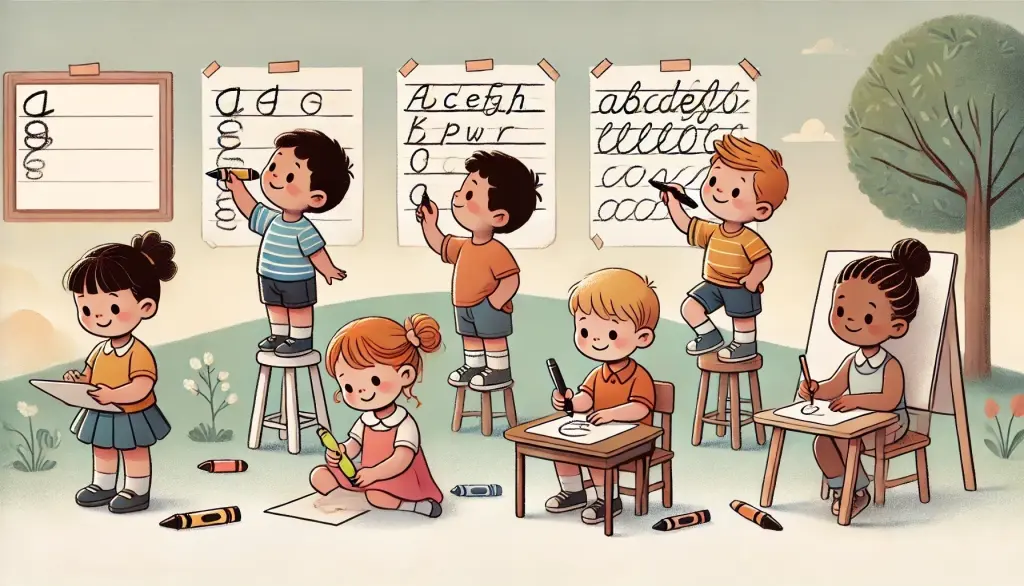
Handwriting development milestones
Developing handwriting skills is a critical aspect of a child's overall growth, impacting not just academic performance but also self-esteem and motor coordination. Understanding typical developmental milestones in handwriting can help parents, teachers, and educators support children at every stage of learning.
Why handwriting development matters
Handwriting is more than just putting pencil to paper. It requires the seamless integration of fine motor skills, visual discrimination, hand-eye coordination, cognitive processing, and understanding language and communication skills. Tracking handwriting milestones enables educators and caregivers to identify early developmental concerns and intervene when necessary.
Below are typical developmental milestones for handwriting development through various age groups:
Handwriting development milestones by age
Ages 0-1 year
- Grasps objects using whole-hand grip (palmar grasp)
- Transfers objects between hands
- Begins to show purposeful scribbling by around 1 year, briefly holding onto crayons or markers
- Develops stronger hand muscles through crawling, gripping objects, and tactile activities
Ages 1-2 years
- Demonstrates better control and motor coordination when gripping crayons (often using a fisted or palmar grasp)
- Experimentation with scribbling, enjoying repetitive marks
- Imitates vertical or horizontal lines upon demonstration toward age two
- Begins to recognize the relationship between marks made on paper and motions of hand and arm
Ages 3-4 years
- Copies circles, lines, and crosses
- Demonstrates a shift from fisted grasp to more refined form such as a digital pronate grasp (finger and palm holding)
- Begins to understand letters and names specific shapes or symbols they draw
- Begins to draw simple representational images like stick figures and faces
- Shows better control in movement, trying to color within lines at around age four
Ages 4-5 years
- Uses a more mature pencil grasp like tripod grasp, though grip styles might still vary
- Begins writing own name independently
- Copies basic geometric shapes, like squares and triangles, and some early letters
- Has increased precision, begins practicing letters with more legibility and accuracy
- Becoming capable of directional control, left to right, top to bottom
Ages 5–6 years
- Writes letters of the alphabet with increased consistency and legibility
- Begins to understand spacing, alignment, and sizing of letters
- Demonstrates improved hand-eye coordination
- Can elevate shapes into patterns, copy short words, and possibly write simple sentences or phrases independently
- Demonstrates proper orientation and directionality of letters and numbers
Ages 6-7 years
- Writes letters and words with increasing speed and efficiency
- Shows a consistent pattern and format (spacing, sizing, and alignment)
- Begins to learn basic punctuation and control spacing between words
- Grows confident in writing sentences, stories, or essays independently
- Gradually introduces cursive handwriting in certain school systems, developing basic cursive letters and joins
Ages 7-8 years
- Maintains a consistent, mature tripod grip
- Has clear and legible handwriting, often attaining fluency and efficiency
- Writes longer paragraphs with minimal physical effort and fewer spelling errors
- Some students continue refining cursive handwriting , demonstrating automaticity and mastery
Supporting handwriting development at home and school
To foster successful handwriting skills, parents and teachers can:
- Do a handwriting assessment: Identify specific strengths and areas for development through informal observation or a formal assessment to tailor support effectively.
- Encourage gross motor development: Crawling, climbing, playing catch, and outdoor activities promote muscle strength.
- Use fine motor activities: Cutting, coloring and tracing lines and curves can improve fine motor skills.
- Demonstrate and provide guidance: Show children how to hold pencils properly, form letters carefully, and use spacing between words.
- Build cognitive understanding: Ask children to identify letters, recognize relevant sounds, and practice letter-symbol skills through visual and tactile methods.
- Practice regularly: Daily or regular sessions in short increments encourage progressive improvement without causing fatigue or resistance.
- Offer positive feedback: Recognition of effort and progress gives children confidence and motivation.
When to seek support
Handwriting delays or difficulties can indicate underlying challenges relating to motor coordination, visual discrimination, cognitive, or developmental concerns. Early intervention and support can significantly increase a child's confidence and skills in handwriting and overall learning.
If a child consistently struggles beyond suggested milestones, it may be useful to consult a specialist, such as an occupational therapist or pediatrician.
In summary
Recognizing and understanding handwriting development milestones supports children's holistic growth, monitoring progress, identifying areas of concern early, and celebrating achievements along the way. With the right support, encouragement, and guidance, children can master competent, confident, and fluid handwriting skills that lay a solid foundation for future academic success.
